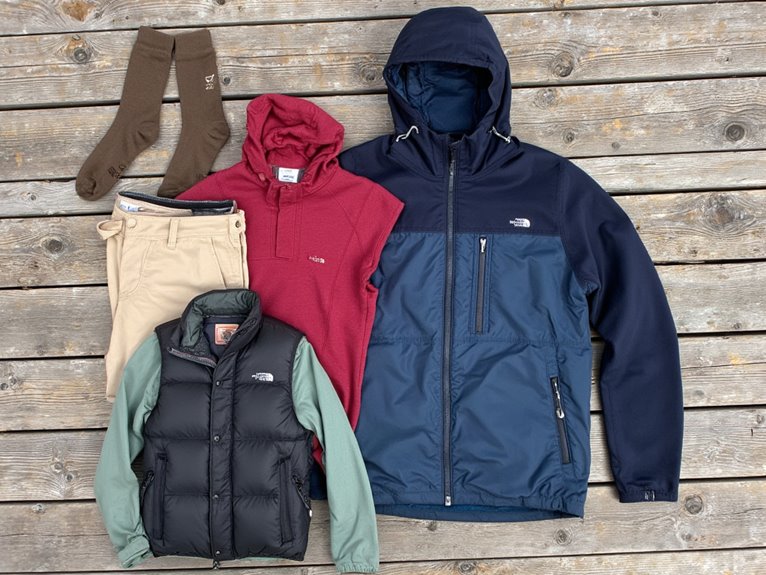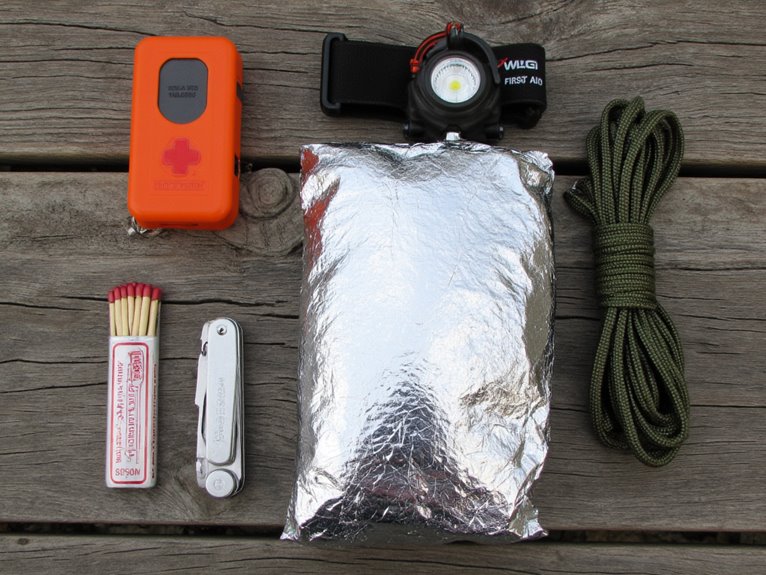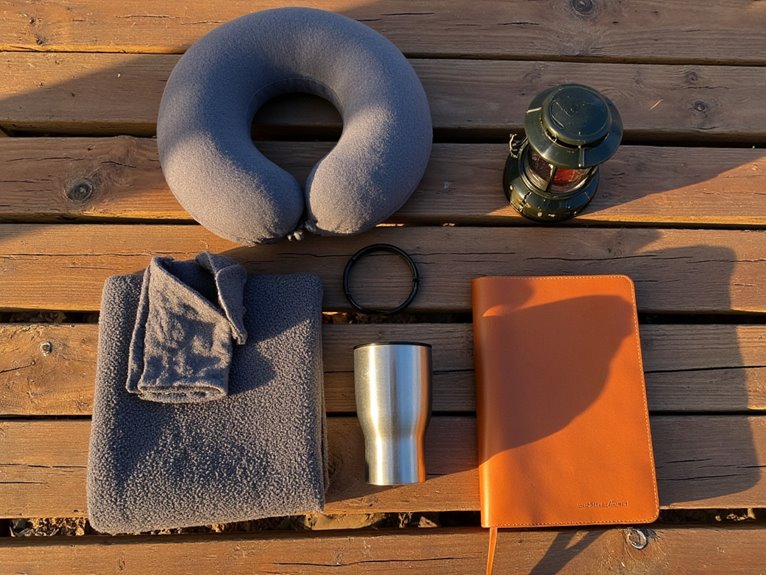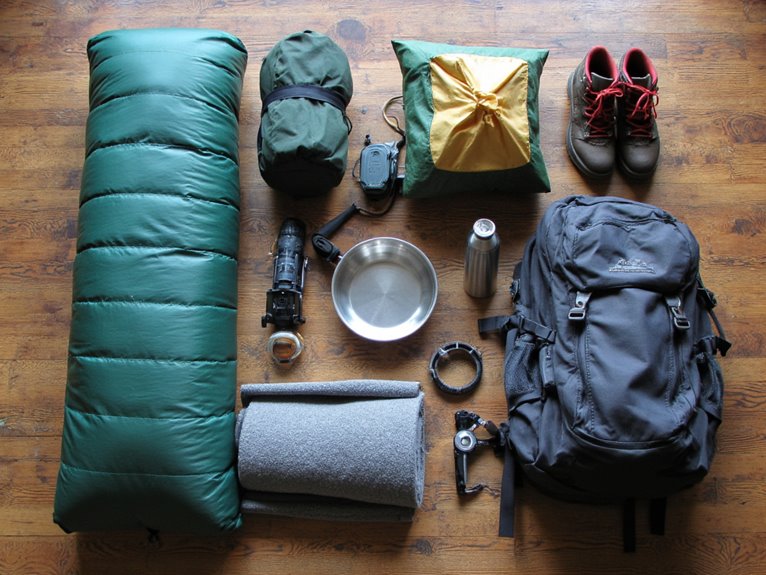How to Pack Smart for a Weekend Camping Trip
You’ll need a two-person tent with reinforced seams, sleeping bags rated 10-15 degrees below expected temperatures, and insulated pads with R-values above 3.0. Pack moisture-wicking base layers, waterproof jackets, and convertible clothing for weather changes. Use nesting cookware sets, bear-resistant food storage, and pre-portion dehydrated meals. Carry a stainless steel multi-tool, repair kit with duct tape patches, and waterproof matches. Organize gear in labeled packing cubes by category. These fundamentals establish your foundation for optimizing every aspect of your weekend adventure.
We are supported by our audience. When you purchase through links on our site, we may earn an affiliate commission, at no extra cost for you. Learn more. Last update on 27th December 2025 / Images from Amazon Product Advertising API.
Notable Insights
- Choose versatile, multi-purpose items like convertible pants and Swiss Army knives to maximize space efficiency.
- Organize gear using labeled packing cubes categorized by sleeping, cooking, clothing, and hygiene for quick identification.
- Select temperature-rated sleeping bags 10-15 degrees below expected nighttime temperatures with insulated sleeping pads.
- Pack essential safety tools including a stainless steel multi-tool, repair kit, and waterproof matches for emergencies.
- Use space-saving nesting cookware sets and pre-portion dehydrated meals to minimize cooking gear and prep time.
Essential Shelter and Sleep Setup for Two Days
When setting up camp for a two-day adventure, your shelter and sleep system forms the foundation of comfort and safety that’ll determine whether you wake up refreshed or miserable.
Choose a two-person tent with weather-appropriate ratings and reliable tent features like reinforced seams and aluminum poles. Position it on flat, well-drained ground away from prevailing winds. Use a footprint underneath for moisture protection.
Select sleeping bags rated 10-15 degrees below expected nighttime temperatures. Mummy-style bags retain heat better than rectangular designs. Add insulated sleeping pads with R-values above 3.0 for ground insulation.
Establish proper gear organization by storing backpacks in the vestibule and keeping essentials like headlamps within arm’s reach. Use a camp lantern for ambient lighting and reflective guylines for nighttime visibility. For weekend car camping trips, consider instant setup tents that can be deployed in under two minutes, eliminating the frustration of complicated assembly after a long day of travel. Consider placing a comfortable mat at your tent entrance to create a welcoming transition zone and reduce dirt tracked inside. A durable Rambler Bowl can serve as an excellent camp dish that maintains food temperature during outdoor meals.
Clothing Strategy for Variable Weekend Weather

Since weekend weather can shift dramatically from scorching afternoons to frigid nights, your clothing strategy must prioritize adaptable layering over single-purpose garments.
Start with moisture-wicking base layers made from merino wool or synthetic fabrics that regulate temperature and manage sweat effectively. Add lightweight fleece jackets or hoodies as mid layers for insulation during cooler periods.
Your outer shell must include a waterproof jacket that doubles as a windbreaker. These layering techniques provide maximum weather adaptability while minimizing pack weight.
Pack convertible items like zip-off pants that transform into shorts. Include a down vest for sudden temperature drops.
Choose versatile footwear: sturdy hiking boots plus lightweight sandals. Essential accessories include merino wool socks, sun hats, and warm beanies. For extremely cold conditions, consider coats with faux fur lining that can provide effective warmth in temperatures as low as 15°F. Rolling your clothes instead of folding saves significant space and improves organization in your pack. Organize clothes using packing cubes for efficient storage and quick access during your trip.
This systematic approach guarantees comfort across variable conditions.
Compact Cooking and Food Storage Solutions
You’ll need to maximize every cubic inch of pack space when it comes to cooking gear and food storage. Space-saving cookware sets that nest together can reduce your kitchen setup to a fraction of normal size, while efficient food storage systems using bear-resistant canisters and lightweight containers keep your provisions safe and organized.
Strategic meal prep techniques like pre-portioning dehydrated foods and using modular packing systems will streamline your entire cooking process from setup to cleanup.
Space-Saving Cookware Sets
The right cookware set can make or break your camping experience, whether you’re backpacking solo or car camping with a group.
Today’s space-saving cookware utilizes innovative materials like titanium and aluminum to deliver maximum functionality with minimal weight. Solo sets weigh under one pound, while detailed group sets rarely exceed several pounds.
Compact designs feature nesting components that stack inside one another, eliminating wasted space. Folding handles reduce footprint by 40-60%. Lids double as plates or frying pans, maximizing utility without additional items.
Titanium offers superior corrosion resistance but costs more than aluminum alternatives. Ceramic-coated surfaces eliminate sticking without added weight.
Essential components include one pot with lid and a small frying pan. Choose sets with secure nesting to prevent rattling and damage during transport.
Efficient Food Storage
While cookware handles the preparation side of camping meals, proper food storage guarantees your ingredients stay fresh, safe, and organized throughout your trip.
Container types matter considerably for food preservation—plastic containers resist breaking and reduce pack weight compared to glass alternatives.
Collapsible storage boxes made from thermoplastic rubber and polyurethane plastic adapt to temperature changes while maintaining durability.
Quality coolers with ice packs maintain perishables below 40°F. Softpack coolers ranging from 7L to 25L provide portability for weekend trips. Hard coolers offer superior insulation for extended periods.
Secure, airtight seals prevent contamination and extend freshness.
- Lockable containers deter wildlife and insects from accessing stored food
- Compartmentalized designs enable efficient packing and quick item location
- Scent-proof bags minimize odors that attract animals to your campsite
Meal Prep Strategies
Since effective meal preparation begins before you leave home, strategic planning transforms your camping kitchen into an efficient outdoor operation.
Batch cooking maximizes your preparation time. Prepare stews, casseroles, and soups in advance, then freeze them flat in resealable bags for space-efficient transport. Pre-marinate proteins using sealed bags to enhance flavor while reducing camp cooking time.
Your meal planning should prioritize one-pot dishes like chili or pasta to minimize equipment needs. Pre-assemble foil packets with proteins, vegetables, and seasonings for direct fire cooking. This eliminates multiple pots and simplifies cleanup.
Focus on ingredient storage using lightweight, stackable containers. Label each package clearly with contents and intended meals. Group ingredients by meal to streamline preparation and prevent overlooking essential items during outdoor cooking sessions.
Must-Have Safety Tools and Emergency Supplies

Your safety in the wilderness depends on carrying the right emergency tools and repair supplies before problems arise.
You’ll need a reliable multi-tool or knife that provides cutting, gripping, and repair functions in a single compact package.
Essential backup items like repair kits and fire safety equipment can mean the difference between a minor inconvenience and a dangerous situation that requires emergency rescue.
Essential Multi-Tool and Knife
A quality multi-tool serves as the Swiss Army knife of camping gear, consolidating essential functions into one compact device that’ll handle most tasks around your campsite.
Multi tool versatility becomes evident through integrated pliers, screwdrivers, can openers, and scissors that eliminate carrying separate tools. Choose stainless steel construction for rust resistance and durability in harsh conditions.
Your camping knife requires sharp blade retention and secure locking mechanisms for safety.
Knife maintenance involves regular cleaning and sharpening to guarantee peak performance during food preparation and rope cutting tasks. Look for one-handed operation features and ergonomic handles that provide secure grip during extended use.
Essential features to prioritize:
- Locking mechanisms that prevent accidental closure during critical operations
- Spring-loaded pliers for enhanced field usability and grip strength
- Lightweight design under 8 ounces for easy portability without sacrificing functionality
Emergency Repair Kit Items
Beyond your multi-tool’s capabilities, camping emergencies demand specialized repair supplies that’ll keep you functional when gear fails miles from civilization.
Pack pre-cut strips of duct tape and repair tape for immediate fixes on torn fabrics, broken tent poles, and damaged rain gear. Include Tenacious Tape fabric patches for durable emergency clothing repairs on jackets and pants.
Your repair kit should contain 50 feet of utility cord, spare buckles, and cord locks for backpack fixes.
Add an extensive sewing kit with heavy-duty thread for lasting repairs. Store safety pins, stretch cords with hooks, and tent-pole repair sleeves for structural emergencies.
Include mattress patch kits and webbing straps with tri-glides.
Organize everything in waterproof containers for quick access during critical situations.
Fire Safety Equipment
Three critical fire safety categories protect campers from both starting unwanted blazes and responding effectively when flames escape control.
Fire extinguisher types for camping include Class A-rated units designed specifically for wood and paper fires. You’ll need a 2.5-pound dry chemical extinguisher with a minimum 8-10 foot discharge range.
Essential fire prevention tips include maintaining cleared perimeters around fire rings, storing flammable materials 15+ feet from flames, and checking weather conditions before ignition.
Pack waterproof matches, fireproof gloves, and designated metal containers for safe tool storage.
Your emergency response kit requires burn cream, sterile dressings, and fire blankets for immediate flame smothering.
Include shovels for covering embers with dirt and portable water containers like RinseKit systems for dousing hot spots.
- Fire suppression canisters provide automatic agent release without manual operation
- Magnesium fire starters produce 5,400°F sparks even in wet conditions
- Emergency whistles enable rapid communication when fires escape containment
Smart Packing and Organization Techniques
When you’re preparing for a camping adventure, implementing strategic packing techniques can transform a chaotic gear pile into an organized system that saves time and reduces stress throughout your trip.
Packing efficiency begins with categorizing gear into specific groups: sleeping equipment, cooking supplies, clothing, and hygiene products. Use labeled packing cubes with clear or translucent materials for quick visual identification.
These organizing techniques include color-coded containers for different categories and durable labeling systems using duct tape or label makers.
Select multi-purpose items like Swiss Army knives and collapsible cookware to maximize space utilization. Choose stackable, heavy-duty storage bins with tight-fitting lids to protect against wildlife infiltration.
For cold weather camping, consider a packable down coat that compresses into a stuff sack weighing only 8-16 ounces while providing essential warmth.
Implement consistent labeling habits and maintain separation between gear types. After each trip, clean and thoroughly dry all equipment before reorganizing containers to preserve your systematic approach for future expeditions.
Comfort Items That Make a Difference

After organizing your essential gear efficiently, selecting the right comfort items can transform your camping experience from survivable to genuinely enjoyable.
Temperature-rated sleeping accessories form the foundation of camp comfort. Choose sleeping bags rated 10-15 degrees below expected nighttime temperatures. Pair these with R-value rated sleeping pads above 3.0 for three-season camping.
Essential hygiene products maintain cleanliness without environmental impact. Pack biodegradable soap, compact toiletries, and quick-dry towels. Portable camp showers provide invigorating relief after long hiking days.
- Lightweight camp chairs with aluminum frames support up to 300 pounds while weighing under 2 pounds
- Headlamps producing 200+ lumens with red-light modes preserve night vision during late activities
- Compact coolers with 3-day ice retention keep beverages cold and food fresh throughout weekend trips
For winter camping conditions, consider synthetic insulation sleeping bags that retain warmth even when damp and include waterproof compression sacks for optimal portability.
Final Preparation and Departure Checklist
The final preparation phase determines whether you’ll encounter preventable setbacks or enjoy a seamless outdoor experience. Complete your final gear inspection systematically. Verify tent components include body, footprint, pegs, and mallet.
Check sleeping bag temperature ratings against weather forecasts. Confirm stove fuel levels and battery charge status for all lighting equipment.
Verify equipment temperature ratings match predicted conditions while ensuring adequate fuel and power reserves for essential gear.
Plan your campsite layout before departure. Identify ideal tent placement considering wind direction and drainage. Organize gear by priority—shelter and cooking equipment should remain easily accessible. Pack waterproof protection for electronics and essential items.
Execute pre-departure protocols methodically. Charge devices and pack backup power sources. Inform contacts of your location and return schedule. Review campsite regulations and permit requirements.
Load vehicles with weight distribution favoring frequently needed items. Schedule arrival during daylight hours for efficient setup. For sleeping comfort, ensure your air mat has a thickness of 3-5 inches to provide adequate pressure relief throughout the night.
On a final note
You’re now equipped with proven packing strategies for weekend camping success. Your shelter, clothing, and cooking systems will handle two-day adventures efficiently. You’ve eliminated excess weight while maintaining essential safety margins. Cross-check your departure list systematically. Verify each item’s functionality before leaving home. Smart packing isn’t about carrying more—it’s about carrying exactly what you’ll need. Execute your plan confidently and enjoy your well-prepared outdoor experience.

